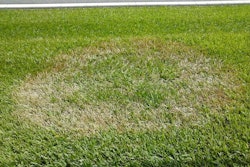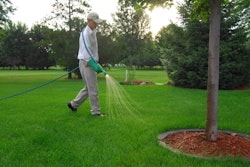Turf pathologists agree that turf managers have to be wary not of new diseases in the coming year, but of the same diseases that continue to be prevalent year after year.
“Across the southeastern United States, the most important diseases in landscape management are those caused by Rhizoctonia solani,” says Lane Tredway, extension specialist in turfgrass pathology at North Carolina State University. “These are brown patch in the cool-season grasses (tall fescue, Kentucky bluegrass, etc.) and large patch in the warm-season grasses (centipedegrass, St. Augustinegrass, zoysiagrass, etc.).”
Rick Latin, professor of plant pathology at Purdue University, says that four diseases top his list as the most prevalent, and, thus, pose the biggest threat to turf on a large scale. These include summer patch, gray leaf spot, leaf rust and red thread.
“Summer patch is sporadic in nature, but can be devastating to a front lawn,” Latin says. “Gray leaf spot can kill plants and blight lawns quickly. Leaf rust is especially a problem on newly seeded lawns and is one of the few lawn diseases that may require fungicide treatment. Red thread is a perennial problem on relatively low-maintenance lawns.”
Brown patch and large patch symptoms
Symptoms of this turf disease can vary with mowing height. For turfgrasses maintained at a height of more than 1 inch, brown patch will present itself in rough, circular patches that are brown, tan or yellow and range in size from 6 inches to several feet in diameter, according to Tredway. When turf leaves are wet or during times of high humidity, you can also see small amounts of gray cottony growth (mycelium) on diseased leaves.
In turf that is maintained at a height of one inch or less, the size of patches can be from a few inches to several feet in diameter, but are brown or orange.
Brown patch can attack bentgrass, bluegrasses, fescues and ryegrasses, and symptoms appear May to September, says Tredway.
“Large patch is a new name for an old disease,” according to Tredway. “This disease was formerly called brown patch, the same disease that affects cool-season grasses during hot weather. Other than the fact that they affect different grasses, there are several important differences between brown patch and large patch that necessitated a name change: They occur at different times of the year, produce distinct symptoms, are caused by different strains of the fungus Rhizoctonia solani, and require very different control strategies.”
Symptoms of large patch are roughly circular patches (initially 2 to 3 feet in diameter, but can rapidly reach up to 10 feet or more in diameter) that are yellow, tan or straw-brown in color, says Tredway.
Large patch can attack bermudagrass, centipedegrass, St. Augustinegrass and zoysiagrass, and symptoms appear August to May.
Control of patch
“Providing a proper growing environment for the turf is a critical first step in managing these diseases,” Tredway says. “Minimizing shade, ensuring good soil drainage, avoiding over-irrigation and applying the proper amount of fertilizer at the correct time is crucial to preventing severe damage from these Rhizoctonia diseases.
“Where the disease has been a persistent problem, preventative fungicide applications are often necessary to prevent unacceptable turf damage,” he says. “Brown patch develops in the summer when night temperatures are consistently above 60 degrees Fahrenheit, whereas large patch develops in the fall and spring when soil temperatures are between 40 degrees and 70 degrees Fahrenheit. These are the times when a preventative fungicide program should be in place. Wherever possible, fungicides should be applied based on the weather conditions, not based on the calendar.”
Fungicides that are very effective in the prevention of both of these patch diseases include azoxystrobin (Heritage) and flutolanil (ProStar). For brown patch, also try pyraclostrobin (Insignia), fludioxonil (Medallion) and trifloxystrobin (Compass). For large patch, also try triadimefon (Bayleton) and propiconazole (BannerMaxx, Propiconazole GPro, Propiconazole Pro, QualiPro Propiconazole, Savvi, Spectator).
Leaf rust
Outbreaks of this disease are most common on residential lawns, says Latin, but also can attack professional landscapes. Leaf rust is caused by a variety of related fungi and occurs almost exclusively on Kentucky bluegrass and perennial ryegrass.
Symptoms of leaf rust are a yellow-green cast on turfgrass. Upon closer inspection, you can also see yellow-orange pustules on turf blades. If you walk through the grass, the rust will leave a distinct orange color on your shoes.
Outbreaks are most common in late summer and early fall, and factors that contribute to poor turf growth tend to favor rust development, according to Latin. These include heat and drought stress, low nitrogen fertility, compaction and shade.
Cultural control options are a good defense against rust. Apply small amounts (0.25 to 0.5 lbs. per 1,000 square feet) of nitrogen fertilizer in chronic trouble spots. Latin says that most rust problems on residential lawns can be controlled through good turf management practices. However, if you are maintaining a large commercial property that has no tolerance for disease, try DMI products (BannerMaxx, Bayleton and Eagle) as well as the strobilurin fungicides (now termed Qol fungicides) such as Heritage, Compass, Honor and Insignia.
Gray leaf spot
This foliar disease affects perennial ryegrass and tall fescue, says Latin. It’s caused by a fungal pathogen (Pyricularia grisea) that infects and kills leaf blades, and can even survive a Midwest winter (although over-winter survival is extremely low).
Affected turf will take on a blue-gray cast and can resemble drought stress. To positively identify this disease, collect a cup-cutter sample and incubate it overnight in a plastic bag, suggests Latin. If it’s gray leaf spot, a distinctive gray mold will be apparent on leaves.
To help suppress the disease, do not irrigate during late afternoon or early evening. If chemical controls are warranted, Latin suggests strobilurins (Heritage, Insignia and Compass) and thiophanate-methyl (Cleary’s 3336 and others).
Summer patch
The summer patch pathogen (Magnaporthe poae) is active during summer, when turfgrass roots grow slowly, and affects Kentucky bluegrass and annual bluegrass. It attacks during periods of environmental stress and limited root growth, Latin says, and is highly dependent on the temperature (hot) and moisture status (wet) of the soil.
Symptoms begin to appear during the heat of summer, and emerge as small (4- to 6-inch) circular patches with an orange-brown color that can grow up to more than 12 inches in diameter.
There are some Kentucky bluegrass varieties with good resistance to summer patch – America, Blacksburg, Classic, Eclipse, SR2100 and SR2109 among them.
Cultural practices that help control summer patch include core aeration or deep-tine aeration in the fall and spring, and deep, infrequent irrigation.
While fungicides can help lesson the severity of this disease, you must apply them when the pathogen is active. Latin says only acropetal penetrant fungicides are recommended because they can better reach roots. Try thiophanate-methyl (Cleary’s 3336F), propiconazole (BannerMaxx), triadimefon (Bayleton) and myclobutanil (Eagle).










